模块9Unit2[上学期]
图片预览
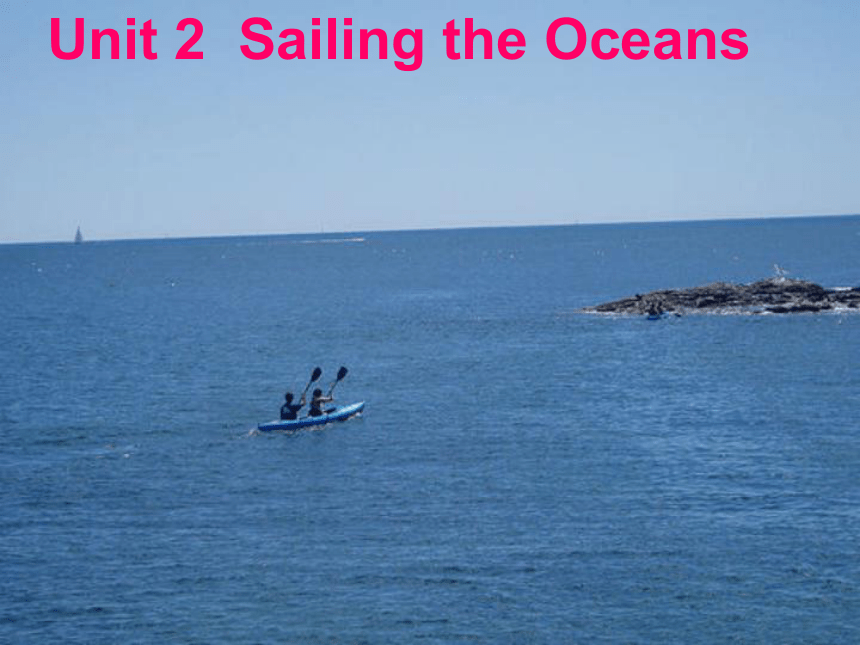

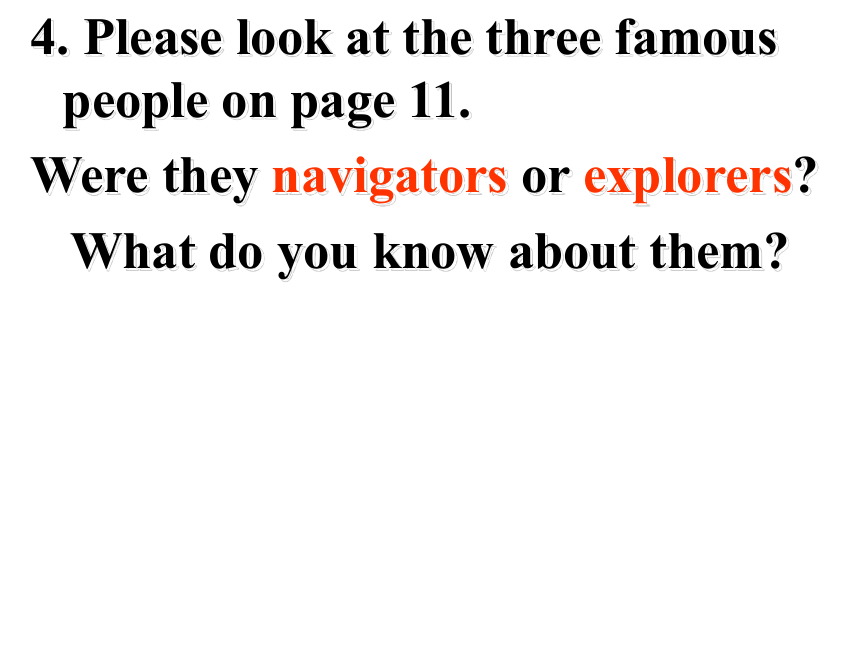
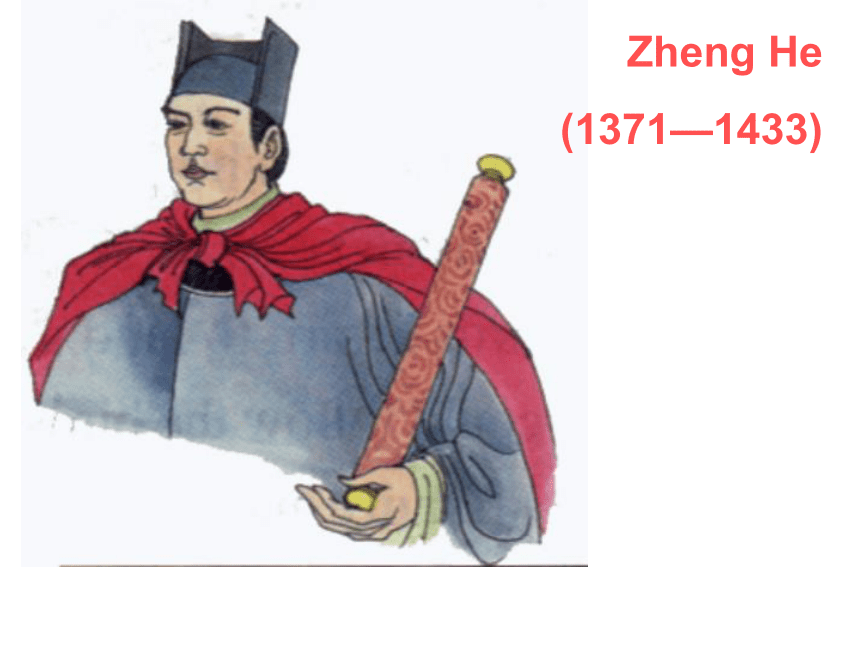
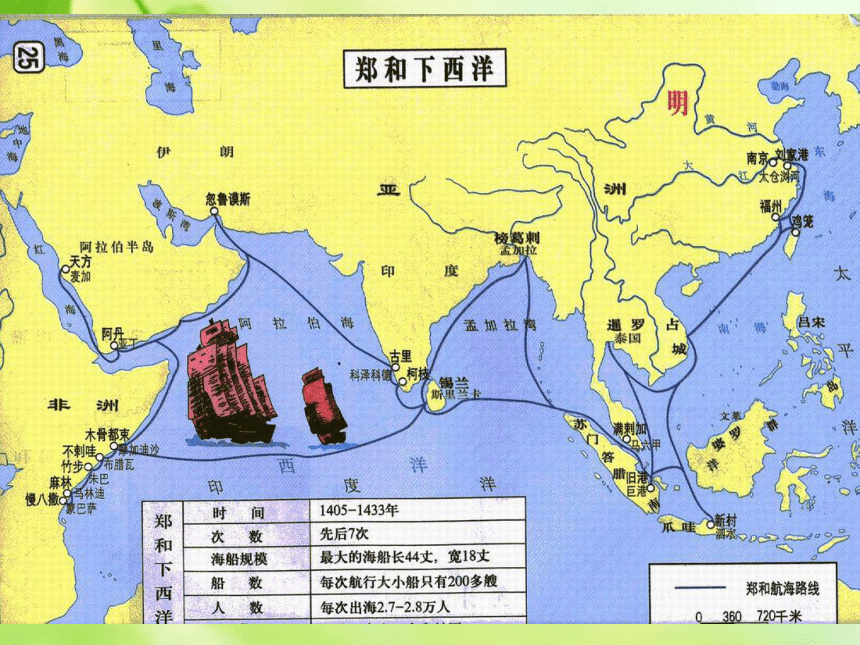

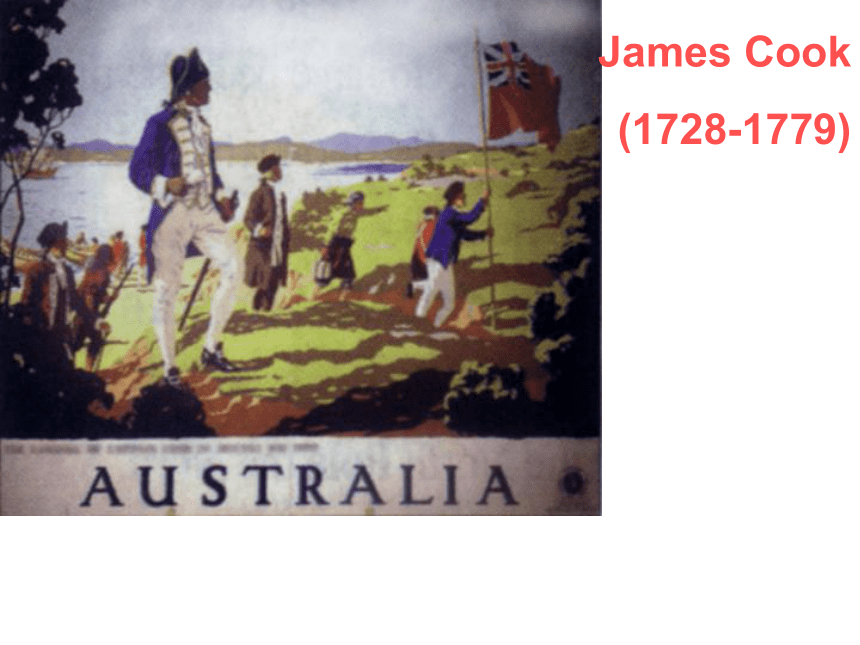
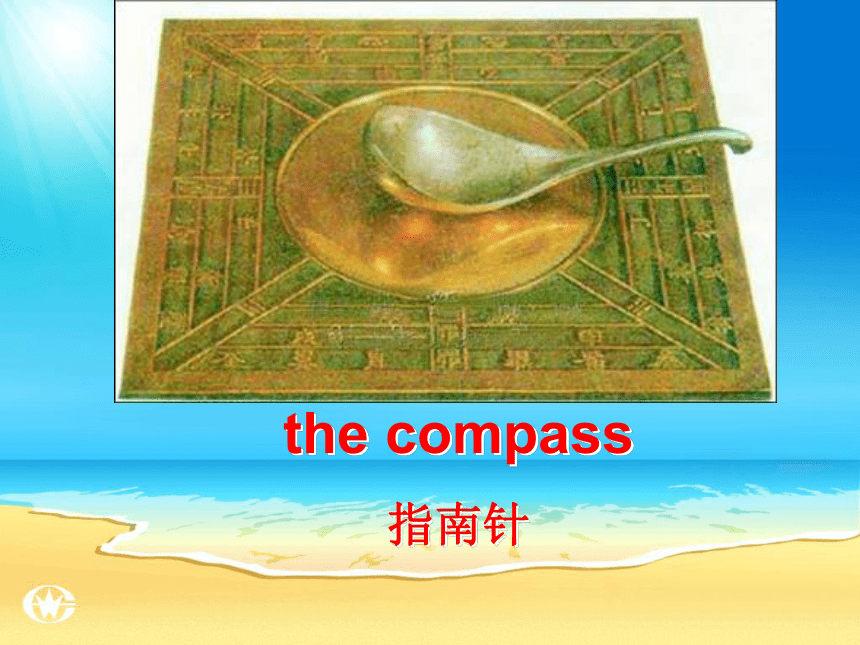
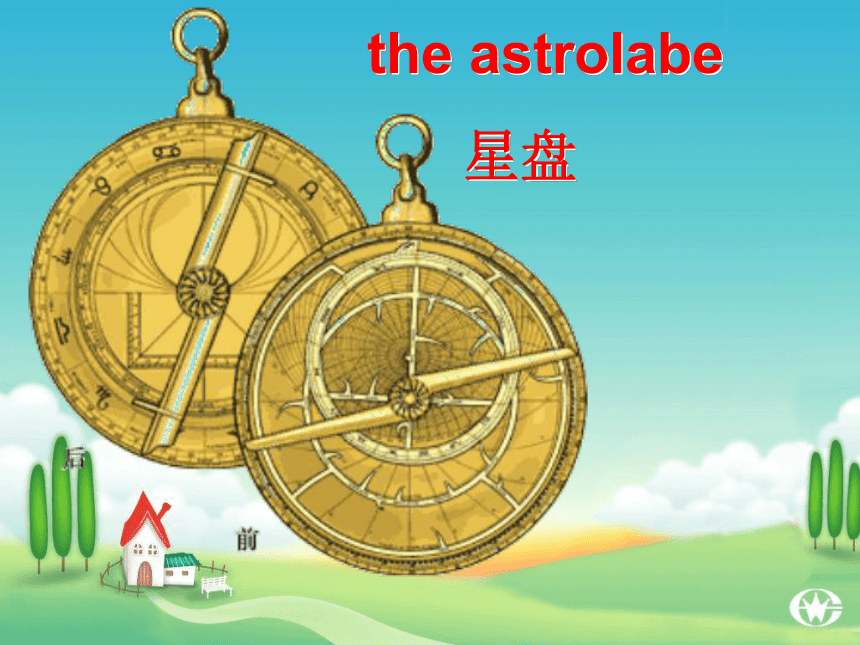

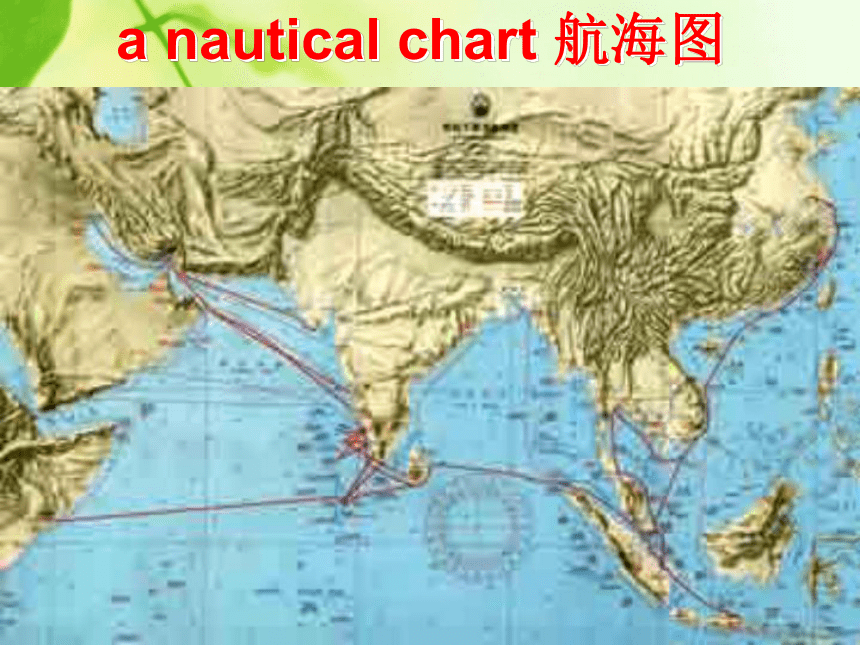
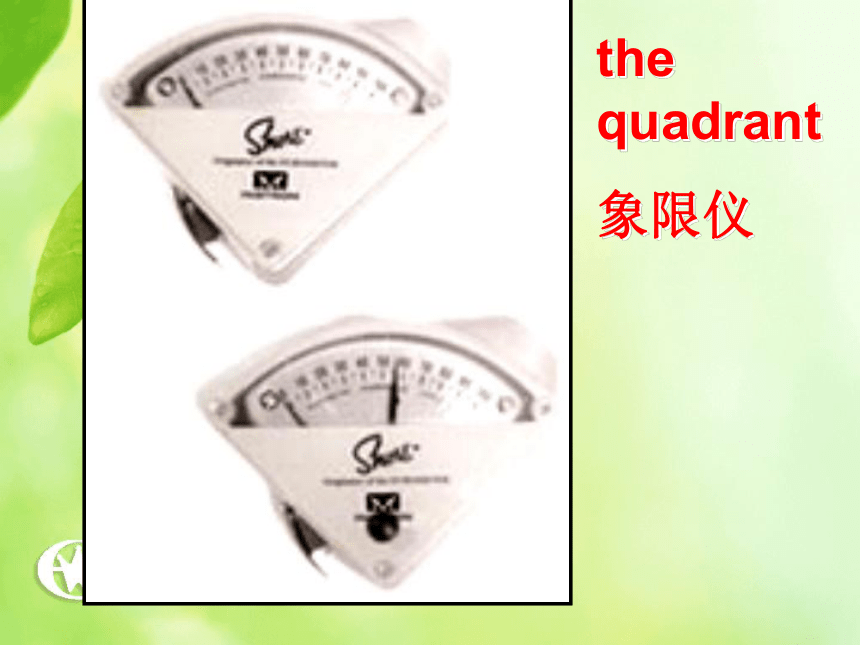
文档简介
课件32张PPT。Unit 2 Sailing the OceansWhat is a navigator?
2. What is an explorer?A navigator explores new routes across the sea.An explorer discovers new places on land.4. Please look at the three famous people on page 11.
Were they navigators or explorers?
What do you know about them?Zheng He
(1371—1433)Marco Polo
(1254-1324)James Cook
(1728-1779)the compass
指南针the astrolabe
星盘the sextant 六分仪a nautical chart 航海图the quadrant
象限仪Reading Task 1Please finish reading the first part of the text (Page 1 from an encyclopedia) in 5 minutes and tell whether the following statements are true or false.
词汇注释:longitude 经度 latitude 纬度
navigate 航海 navigator; navigational
the Vikings (8—10世纪时劫掠欧洲西北海岸的)北欧海盗
plunge (船)前后颠簸( )1 Keeping alongside the coastline is the safest way for navigation.
( )2 Wherever you are, the North Star is at its highest position in the sky.
( )3 Sailors could use the sun to work out their latitude any time they liked.
( )4 A special cloud formation can tell sailors that land is not far away.
( )5 Any seaweed can tell sailors that land is nearby.
( )6 Sailors can follow sea birds to land in the morning.
( )7 Winds, certain tides and currents might be useful for navigation.
( )8 The main topic of Page 1 is “Using celestial bodies”.( )1 Keeping alongside the coastline is the safest way for navigation.
( )2 Wherever you are, the North Star is at its highest position in the sky.
( ) Sailors could use the sun to work out their latitude any time they liked.
( )4 A special cloud formation can tell sailors that land is not far away.
TFFT( )5 Any seaweed can tell sailors that land is nearby.
( )6 Sailors can follow sea birds to land in the morning.
( )7 Winds, certain tides and currents might be useful for navigation.
( )8 The main topic of Page 1 is “Using celestial bodies”.FFTFReading Task 2Please finish reading the second part of the text (Page 2 from an encyclopedia) in 8 minutes and do the following exercises.
1) The text ______ how the British solved the theoretical problem about measuring longitude.
A tells us B doesn’t tell usBComprehending2) What is the use of a bearing circle,
astrolabe, quadrant or sextant? ( )
What is the use of a compass? ( )
A. To set the course of the ship
B. To measure the position of the ship
C. To measure the speed of the ship
D. To tell the timeAB3) An early method of measuring speed involved a knotted rope and a log. Sailors threw _____ into the sea to do it.
A the log B the knotted rope
C both A and BA4) ______ was the first instrument to measure the sun’s position.
A The bearing circle
B The astrolabe
C The quadrant
D The sextantA5) Of the early navigational instruments, the astrolabe, the quadrant and the sextant, ________________ was a better one while _______________ was the best one.the quadrantthe sextantLanguage Focus 01 at the mercy of the sea
任凭大海摆布
02 The opposite of “minimum” is “____________”.maximum03 accomplished navigators熟练的=skilled04 celestial bodies天体05 They can use the height of the sun to work out their latitude.计算出06 Sailors could tell by the colour and
smell how long the seaweed had been there.判断根据07 The sailors could use the sun overhead at midday to navigate by.根据08 Sea birds could be used to show the way to land when it was nowhere to be seen.land09 nesting birds 筑巢而居的10 Seamen could follow the birds to land even if they were offshore and in the open sea.Sailors远离海岸辽阔的大海11 tides and currents 潮汐洋流12 a secure method reliable可靠的13 a knotted rope打了结的14 mathematical tables 数学表15 a magnetic pointer 磁针16 a special all-in-one tool 集多功能为一体的17 However, it was awkward to use
as one of the points of reference
was the moving ship itself.笨拙的because参照点18 It was easier to handle because it
was more portable.use; deal with19 Its shortcoming was that it still used the moving ship as one of the
fixed points of reference.作为20 As the ship rose and plunged in
the waves, it was very difficult to be accurate with any reading.When;While21 The sextant was the updated
version of the astrolabe and
quadrant which reduced the
tendency to make mistakes. 更新过的版本the updated versionpossibilityHomework 1. Review the text on pages 12--13.
2. Finish Exercise 4 on page 16.
2. What is an explorer?A navigator explores new routes across the sea.An explorer discovers new places on land.4. Please look at the three famous people on page 11.
Were they navigators or explorers?
What do you know about them?Zheng He
(1371—1433)Marco Polo
(1254-1324)James Cook
(1728-1779)the compass
指南针the astrolabe
星盘the sextant 六分仪a nautical chart 航海图the quadrant
象限仪Reading Task 1Please finish reading the first part of the text (Page 1 from an encyclopedia) in 5 minutes and tell whether the following statements are true or false.
词汇注释:longitude 经度 latitude 纬度
navigate 航海 navigator; navigational
the Vikings (8—10世纪时劫掠欧洲西北海岸的)北欧海盗
plunge (船)前后颠簸( )1 Keeping alongside the coastline is the safest way for navigation.
( )2 Wherever you are, the North Star is at its highest position in the sky.
( )3 Sailors could use the sun to work out their latitude any time they liked.
( )4 A special cloud formation can tell sailors that land is not far away.
( )5 Any seaweed can tell sailors that land is nearby.
( )6 Sailors can follow sea birds to land in the morning.
( )7 Winds, certain tides and currents might be useful for navigation.
( )8 The main topic of Page 1 is “Using celestial bodies”.( )1 Keeping alongside the coastline is the safest way for navigation.
( )2 Wherever you are, the North Star is at its highest position in the sky.
( ) Sailors could use the sun to work out their latitude any time they liked.
( )4 A special cloud formation can tell sailors that land is not far away.
TFFT( )5 Any seaweed can tell sailors that land is nearby.
( )6 Sailors can follow sea birds to land in the morning.
( )7 Winds, certain tides and currents might be useful for navigation.
( )8 The main topic of Page 1 is “Using celestial bodies”.FFTFReading Task 2Please finish reading the second part of the text (Page 2 from an encyclopedia) in 8 minutes and do the following exercises.
1) The text ______ how the British solved the theoretical problem about measuring longitude.
A tells us B doesn’t tell usBComprehending2) What is the use of a bearing circle,
astrolabe, quadrant or sextant? ( )
What is the use of a compass? ( )
A. To set the course of the ship
B. To measure the position of the ship
C. To measure the speed of the ship
D. To tell the timeAB3) An early method of measuring speed involved a knotted rope and a log. Sailors threw _____ into the sea to do it.
A the log B the knotted rope
C both A and BA4) ______ was the first instrument to measure the sun’s position.
A The bearing circle
B The astrolabe
C The quadrant
D The sextantA5) Of the early navigational instruments, the astrolabe, the quadrant and the sextant, ________________ was a better one while _______________ was the best one.the quadrantthe sextantLanguage Focus 01 at the mercy of the sea
任凭大海摆布
02 The opposite of “minimum” is “____________”.maximum03 accomplished navigators熟练的=skilled04 celestial bodies天体05 They can use the height of the sun to work out their latitude.计算出06 Sailors could tell by the colour and
smell how long the seaweed had been there.判断根据07 The sailors could use the sun overhead at midday to navigate by.根据08 Sea birds could be used to show the way to land when it was nowhere to be seen.land09 nesting birds 筑巢而居的10 Seamen could follow the birds to land even if they were offshore and in the open sea.Sailors远离海岸辽阔的大海11 tides and currents 潮汐洋流12 a secure method reliable可靠的13 a knotted rope打了结的14 mathematical tables 数学表15 a magnetic pointer 磁针16 a special all-in-one tool 集多功能为一体的17 However, it was awkward to use
as one of the points of reference
was the moving ship itself.笨拙的because参照点18 It was easier to handle because it
was more portable.use; deal with19 Its shortcoming was that it still used the moving ship as one of the
fixed points of reference.作为20 As the ship rose and plunged in
the waves, it was very difficult to be accurate with any reading.When;While21 The sextant was the updated
version of the astrolabe and
quadrant which reduced the
tendency to make mistakes. 更新过的版本the updated versionpossibilityHomework 1. Review the text on pages 12--13.
2. Finish Exercise 4 on page 16.
同课章节目录
